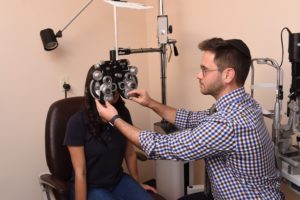Your brain is very flexible and adaptive, especially with issues that develop gradually. A good example of this is if you put on a pair of red tinted glasses. At first everything has a red hue, but within a short time you will no longer notice the difference. When you remove those glasses, the natural light will be what seems unnatural. Your brain adapts to the signals it receives and compensates. It tries to do the same when the issue is more severe than a pair of red tinted glasses, when your vision may be clouded or not as focused as it used to be.
Why are Eye Exams Important?
People typically see their eye doctors hoping to improve their eyesight. What they often don’t realize is that over 200 major, systemic diseases have eye involvement as part of the disease course. There are a multitude of ocular manifestations of systemic disease. Ophthalmologists are positioned perfectly to be able to identify these illnesses before anyone else and get patients to appropriate treatment before symptoms develop or progress. Comprehensive eye examinations definitely help preserve and improve vision, but more importantly, they often save lives. On our blog, we elaborate on nine life saving reasons to schedule an annual exam.
Like all medical issues, catching a problem in its earliest stages makes it easiest to treat. Your eyes are no different. Annual comprehensive eye examinations are important for the health of your eyes. In addition to checking your vision, a comprehensive eye examination can help a doctor diagnose and treat common eye diseases before they impact your overall health. Just because you think your vision is fine does not mean it has not degraded without you noticing.
Drs. Mendelsohn and Klein specialize in diabetic eye disease and treat about 1,000 diabetics in the practice. We are extremely proud of our track record of preserving excellent vision in our diabetics! Please view our video on the prevention of diabetic retinopathy. We also have a significant number of patients with thyroid disease with its myriad of manifestations of thyroid eye disease.
What Happens During a Comprehensive Eye Examination?
When you visit Dr. Alan Mendelsohn or Dr. Nathan Klein for your comprehensive eye exam, you may be taken through a series of eye exams. Some of these you may be familiar with (such as reading an eye chart) while others might be unfamiliar to you.

Each exam your doctor takes you through tests a specific function of your eyes and checks for specific issues. The most common is the “visual acuity test,” which generally uses a standard eye chart to measure how well you can see objects at a distance as well as a chart used to measure your near vision.
With a comprehensive eye exam, diagnostic testing may be performed which can include the following: OCT diagnostic tests of the macula and optic nerve, Optomap, and Humphrey peripheral visual field analyzer. Drs. Mendelsohn and Klein can detect glaucoma, diabetic retinopathy and/or maculopathy, macular degeneration and dozens of other ocular or systemic conditions at their very incipient stages, thereby preventing vision loss. Optical Coherence Tomography (OCT) uses light waves to create detailed, high resolution, cross-sectional images of the retina and optic nerve to detect the onset of ocular diseases at exceedingly early stages. Drs. Mendelsohn and Klein have the most technologically advanced and accurate OCT, the Zeiss Cirrus HD-OCT, at the office because the earliest detection and highest degree of accuracy is of paramount importance to us. In an amazing technological breakthrough, highly magnified digital images are produced by Optomap scanning laser technology of the back of the eye, providing your physicians with an unparalleled view of the optic nerve, retinal nerve fiber layer, macula, and the entire retinal surface area. The Humphrey Visual Field Analyzers that our physicians utilize are an important tool in the diagnosis and management of glaucoma, strokes, mini-strokes, MS, and a myriad of systemic conditions. It is also used to confirm that glaucoma has affected the visual function, to evaluate the severity, and to monitor progression of the disease. The Humphrey Visual Field Analyzer is the recognized standard of care for early diagnosis and management of ocular diseases resulting in visual field loss.
Another common exam is the “cover test.” This is when the doctor uses a small paddle to cover one eye and then the other to determine how well they work together. This helps in determining if you are showing any symptoms of amblyopia, which is more commonly referred to as “lazy eye”.
Another test given early on during the exam is one that tests for color blindness. This not only determines if you have difficulty seeing certain colors but could also be an indicator of other eye health problems so is an important and very common exam.
From there, the doctor may proceed through a variety of exams, each testing for specific issues or symptoms. From a slit lamp exam, which helps detect cataracts and macular degeneration, to a dilated eye exam, which allow your doctor a better view of the inner workings of your eye, each exam has a role to play in determining the state of your eye health.
Signs it is Time for an Eye Exam
Subtle vision changes can go unnoticed but have an impact on the quality of your life. Headaches, eyestrain and not seeing colors as vibrantly as you once did can be the side effects of vision change. You shouldn’t ignore these signs and you certainly don’t have to resign yourself to them.
If you are in need of an eye examination, be sure to contact Eye Surgeons and Consultants of Hollywood, FL. Remember, eye disease caught early on have the best change of successful treatment. Call today!
